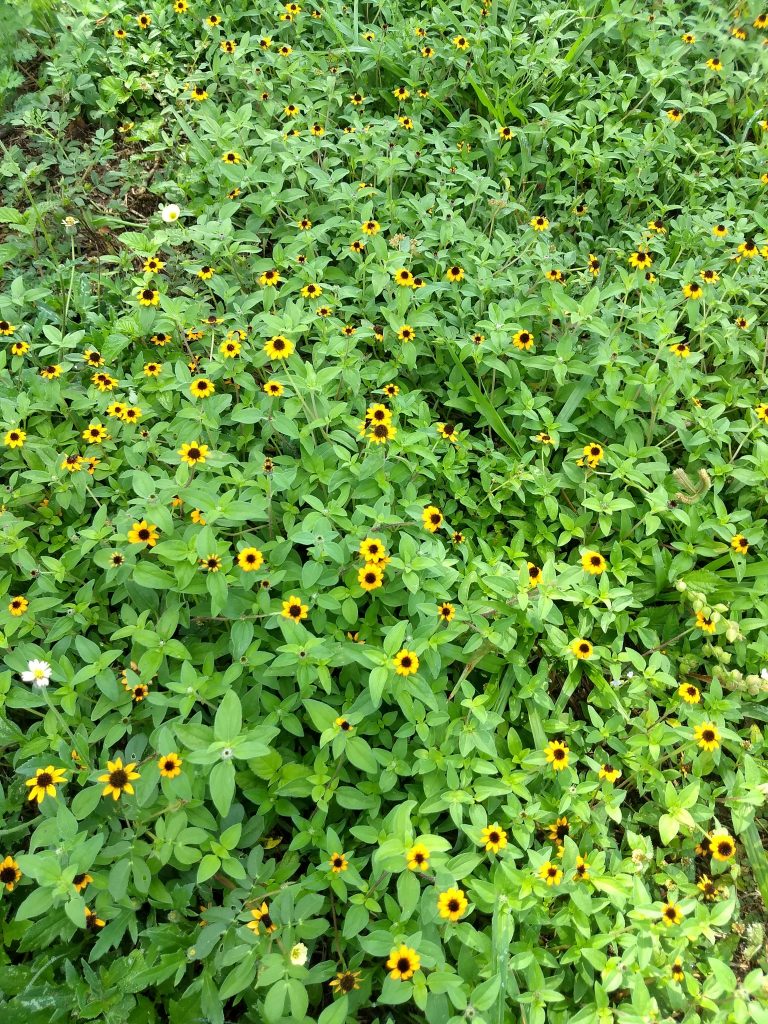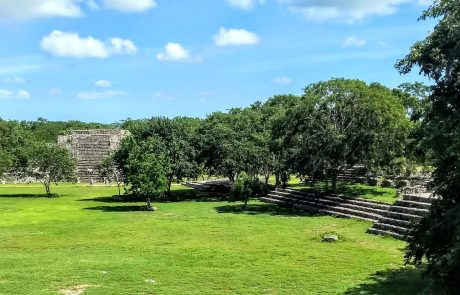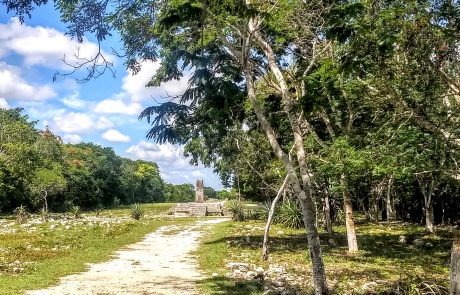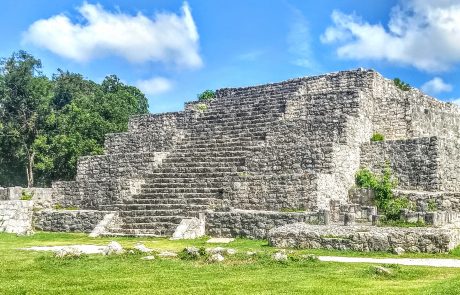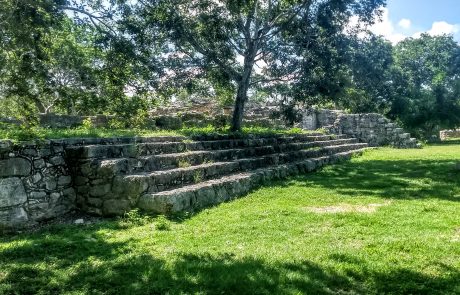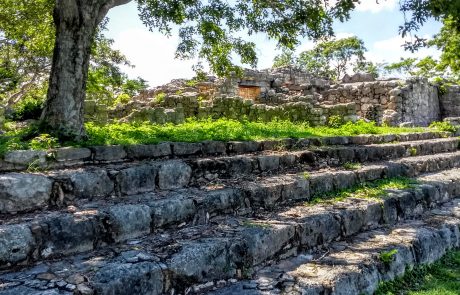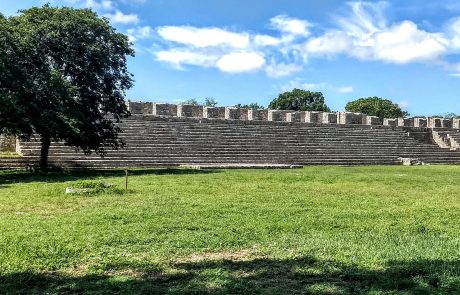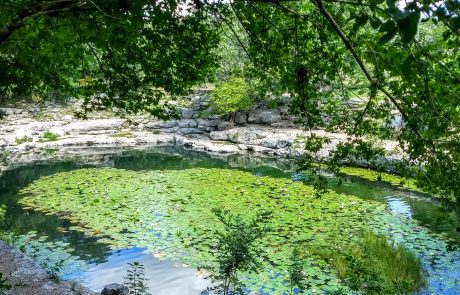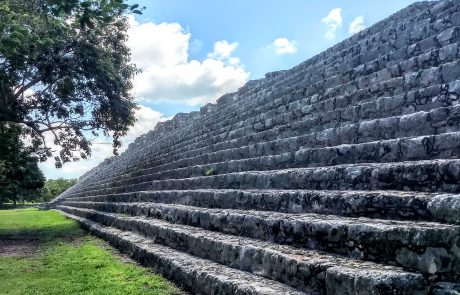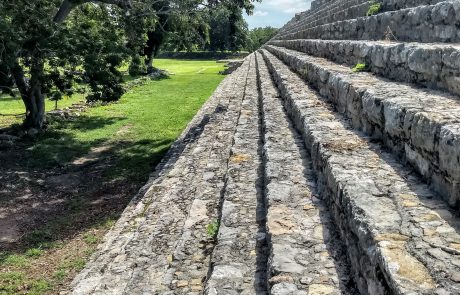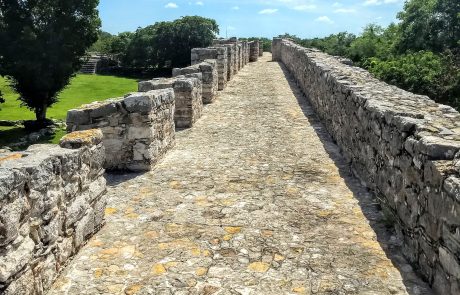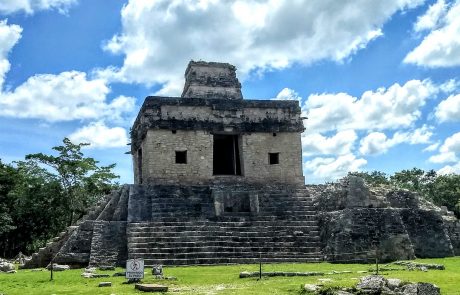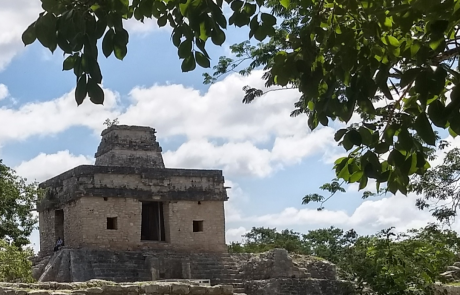September 2019
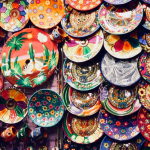 I’ve been in Merida less than a week but I already feel like an expert. There’s a good reason for that: there’s not much there there. That may seem to some a summary dismissal of The White City, but after driving through it from one end to the other for nearly a week I have the evidence of my own eyes as corroboration. My experience leads me to wonder what controlled substance is in use by the people whose blog posts and articles I’ve read on the Internet. It can’t be that I’m missing something because I’ve driven through all the tourist hotspots more times than I care to remember. The fact that everything melts down in my head into a mediocre sameness can’t be due solely to my own faulty perception. My eyes work just fine, thank you very much, and I still have my wits about me despite having spent far more hours in Merida traffic than I planned or wanted. So I’ll limit my comments on Merida to generalities. There are no accompanying pics. I saw no point in making the effort to capture what can be reproduced from the urban footprint of any other Mexican city you care to name and there’s plenty of documentary evidence in Google Images already.
I’ve been in Merida less than a week but I already feel like an expert. There’s a good reason for that: there’s not much there there. That may seem to some a summary dismissal of The White City, but after driving through it from one end to the other for nearly a week I have the evidence of my own eyes as corroboration. My experience leads me to wonder what controlled substance is in use by the people whose blog posts and articles I’ve read on the Internet. It can’t be that I’m missing something because I’ve driven through all the tourist hotspots more times than I care to remember. The fact that everything melts down in my head into a mediocre sameness can’t be due solely to my own faulty perception. My eyes work just fine, thank you very much, and I still have my wits about me despite having spent far more hours in Merida traffic than I planned or wanted. So I’ll limit my comments on Merida to generalities. There are no accompanying pics. I saw no point in making the effort to capture what can be reproduced from the urban footprint of any other Mexican city you care to name and there’s plenty of documentary evidence in Google Images already.
The backstreets of Merida are like the backstreets of any other Mexican city — or town, for that matter. Single storey buildings of concrete and stucco stacked next to each other, most often with a communicating wall — something that puzzles me in a country with so much space available. In the past few days I’ve walked at length through the central district, the Centro with its flagship avenue the Paseo de Montejo which is Merida’s claim to fame. Well … if I say what I think I’m going to get myself into trouble, so let’s leave it at “counterclimactic.” And that one street is it, babes. After that you’re awash in faded colonial-style streets with sidewalks barely wide enough for one person. One supposes that people were much smaller in those days — no other explanation for the measly sidewalks springs to mind. So it’s our fault for becoming bigger, that must be the trouble.
I’ve been travelling for nigh on three years now and the visit to Merida pushed me over a threshold. As I’ve been walking and driving around the city a single thought has surged repeatedly into awareness: all people really do is shop, eat and reproduce. Yes, they build stuff, but that’s usually done cookie-cutter style these days. The Paseo de Montejo, for example, is touted as the architectural zone ne plus ultra of the White City, yet it’s a spotty mishmash of 19th century mansions tipping their hats rather too obviously to the likes of the Palais Garnier in Paris, sometimes missing the point entirely as they descend into an eclectic chaos of broken arches, gee-gaws and finials. We are amused but not particularly impressed. We would as soon go to Paris to see the Palais Garnier itself in all its cool elegance. Alongside the Frenchified structures the Paseo offers up all manner of modern architecture strung together higgeldy-piggeldy. Some modern buildings use neoclassical architectural elements to try to pass off as historical, others are completely modern and would do just fine in downtown Chicago. There’s no such thing as zoning in Mexico, either, so God only knows what you’ll find stacked next to each other.
To be honest, we’ve seen it all before. The threshold over which the Paseo catapulted me was impatience with the unimaginative offerings of a modern city regardless of its location on the globe. You can shop. You can eat. You can walk around while the traffic swirls past you. What a meagre repertoire of activity. I’d much rather fix my attention on the natural world with its stupefying variety and ingeniousness. I don’t really need to see another Hyatt Regency. I’m now certain doing so will not make me a better person. It has certainly done nothing of the sort for me in Merida.
The reason I’m in the Yucatan Peninsula has nothing to do with the Paseo, in point of fact. I came here for two reasons: to experience the natural environment of the Peninsula and to visit several Mayan archeological sites. I organized the trip with the precision of a dental technician doing a deep cleaning. The days are mapped out so that I know exactly where I will be along the course of the hours. Of course there’s room for spontaneity, but not for dilly-dallying. We have things to see and places to go, oh yes we do. So without further ado let me discuss the first site I visited: Dzibilchaltun, just a bit north of Merida.
It’s an easy get from the city on the highway that goes to the coastal town of Progreso — the beach spot for Merida. The highway is what’s called “libre” — meaning it doesn’t have tolls. If you have wheels then it’s about a half hour to get from the city center to the archeological site, which is about the same amount of time it takes to get from one end of the city to other, as it so happens. I found my half hour much, much more amply rewarded by directing myself to Dzibilchaltun than by stopping-and-starting through the streets of Merida.
First, a shoutout for Steve Mellard and his website “The Mayan Ruins Website” (here) — it’s by far the best resource I’ve found for information on Mayan sites for both the ample nature of the information given and because it’s carefully organized by country and location so that finding info on a particular site is a breeze. I’ve used Mr. Mellard’s site many, many times in both planning and executing my visits to Mayan sites in Yucatan. Don’t leave home without it.
Rather than drone on using information I’ve gathered from various sources, I’ll let the description from Mr. Mellard’s website do the talking:
Dzibilchaltun was originally known as Ch’iy Chan Ti’Ho This well-known site is renowned for the appearance of the sun shining through the doorway of the Temple of the Seven Dolls on the spring equinox. The ruins are a short drive north from Merida just off Highway 261 on the turnoff to Chablekal. The site at one time covered approximately 12 sq. miles/19 sq. kms, however the current core zone is much smaller and easily visited.
It has been estimated that upwards of 40,000 people inhabited the site and surrounding area. There are three main plazas in addition to the Temple of the Seven Dolls which is located at the east end of a long sacbe (raised stone causeway). Apart from being an archaeological zone it is also a National Ecological Park.
The site has a fine museum with numerous stone monuments and statues found at the site and surrounding area, along with a complete history of the Yucatan with an emphasis on the Caste War 1847-1901.
The entrance fee is fairly hefty for foreigners — some of the major archeological sites have differential pricing for Mexican citizens and foreigners, Dzibilchaltun happens to be one of them. The same is true of Uxmal and Chichen Itza. Others of less developed nature, for example the Ruta Puuc sites of Kabah, Sayil and Labna, have one price for all visitors. The more developed sites have more facilities — visitor centers with proper bathrooms, a cafe perhaps, and in the case of Dzibilchaltun, a museum in a very nice building. It’s a small collection and compared with the Museo del Mundo Maya in Merida it’s a pipsqueak, but it’s a pleasant wander if you visit Dzibilchaltun.
Dzibilchaltun is not particularly impressive for the number of buildings it has on view. The setting itself is worth half the price of admission, in my humble opinion, because it gives you the opportunity to wander about in the natural setting and even to swim in the cenote if you want. Here are some introductory pics:
There are two main areas, one with the pyramids and one with the Temple of the Seven Dolls at the far end of the site. The first pic shows the general layout of the first area, which contains the bulk of the archeological action. The second pic shows a stelae that stands at the entrance to the area of the Temple of the Seven Dolls. It’s a fair hike from one area to the other and fortunately there’s a gravel pathway along the edge of the woods — aka jungle — that surrounds the site. If you’ve not been to the Yucatan Peninsula before in the rainy (i.e. hot) season, be advised: you’re gonna sweat like a stuck pig. Word on the street is that things cool down about December and stay on the cooler side until April, but after experiencing the heat the Pensinsula swelters under during the rest of the year I’m not sure how much I believe the word “cooler” in association with the Yucatan. I think their “cool” may just be another word for what we folk from the Bitter North call “hot.” In any case, it’s impossible to choose a cool part of the day in the rainy season since as soon as the sun comes up the party begins and the temperature and humidity — at times 80% or more — will soon put paid to the idea of beating the heat. Dzibilchaltun was my first go at visiting a site and although I got an early start I didn’t beat the heat — the heat beat me. I was dripping sweat like a stuck pig half an hour into the wandering. At that point my strategy for all future site visits formulated itself in one tidy thought: “Let it sweat.” I resigned myself to completely destroying the clothing I had on for any further use that day or any other day until it had been through a laundry. That’s exactly how things continued. Get up early, get to the site, do the wandering and get the pics, sweat like a stuck pig, hang out in the shade for a while so you don’t soak the car seat when you get in the car to go back to the hotel, get to the room, get out of those nasty clothes and shower, then into the second outfit for the day that you wear while staying OUT of the sun. Two outfits a day I can manage, anything more than that puts me in the Kardashian Zone and homey don’t play that.
If the truth be told the buildings at Dzibilchaltun are not spectacular compared to other Mayan sites in the area, but the site is lovely and the cenote is stunning with its blanket of water lilies. I’ll give you a pic gallery of the main area then move on to the area with the Temple of the Seven Dolls.
The cenote is right on the edge of the main plaza area, which makes perfect sense since cenotes are the only source of fresh water in the Yucatan Peninsula other than rainfall. If you had one on your doorstep you were in the pink as far as water supply goes. I don’t imagine back in the day the Mayans used it as a swimming pool like the visitors to Dzibilchaltun do today — at least one hopes not — but nobody’s pulling their drinking water from it these days so no harm done, I suppose.
After having visited several Mayan sites I can say from the perspective of a backward glance that Dzibilchaltun doesn’t really convey the amplitude of Mayan sites. The unexcavated area in Dzibilchaltun is far larger than the portion restored and available for exploration. In places like Uxmal you clearly get the sense that the major sites were full-on cities with tons of buildings and what must have been an extremely busy civic agenda, as well. I went to Dzibilchaltun after bopping around in Merida for three days and it was heavenly to be in a natural setting with nothing to hear but the birds. For that reason alone Dzibilchaltun holds a spot in my affections. The area is lovely and I enjoyed checking out the jungle around the site to get a read on the kinds of plants and trees in it.
The only other major building to see at Dzibilchaltun is the Temple of the Seven Dolls, so named because seven dolls were found in it when it was being excavated. Here’s the info from the Wikipedia page on the site (here):
The most famous structure is the Temple of the Seven Dolls, so named because of seven small effigies found at the site when the temple was discovered under the ruins of a later temple pyramid by archaeologists in the 1950s.[2] On the vernal equinox, the site is crowded by visitors observing the sunrise through the temple’s doorways, but there is no archaeological feature marking the observation spot; the relationship of the orientation with the equinoxes is thus highly unlikely.[3] The temple is connected to the rest of the site by a sacbe, or “white road,” so-called because they were originally coated with white limestone, built over stone-and-rubble fill.
You could have fooled me about the link between the two areas by means of a “sacbe” — a raised road essentially like the platforms on which temples were built. I didn’t get a clear sense of how a sacbe works structurally until I saw the one at Labnah. So I’ll leave discussion of the white road thing for the post on the Ruta Puuc sites.
The Temple of the Seven Dolls may well be the most famous building at Dzibilchaltun, but it’s not necessarily the most impressive in my opinion. It’s no longer possible to ascend the steps to see the building up close. At the time of its heyday there were clearly many other buildings around it, but those are now no more than stones on the ground marking out spaces where once buildings stood. It’s quite a modest thing, much smaller than the buildings in the main plaza area, so I’ll give it its tourist due with a few pics and call it good.
The museum is located near the visitor center. It’s quite a handsome modern building but the lighting is wholly inadequate for seeing the exhibits. The AC is also less than impressive, which in combination with the mood lighting made my trip through the building a very quick one. Given that the Museo del Mundo Maya is only 10 miles away in Merida and offers one of the most spectacular collections of Mayan artefacts in the world, the museum at Dzibilchaltun can only pale in comparison. It’s fine for a wander if you’re at the site but decidedly not a draw in and of itself.
If you’re in Merida and have the means to get there (e.g. a car) then Dzibilchaltun is well worth the short drive. If you’re a nature lover like me you’ll find yourself rewarded by a delightful park setting as well as by the Mayan ruins. The only thing I found disagreeable about the site was the remnant of the Spanish church stuck right in the middle of the main plaza area. The Conquista was not a pretty thing, I don’t care what spin you give it, and the church remnant is a piece of ugliness among the handsomeness of the Mayan buildings the site offers. I was pleased to find no such nonsense in the other Mayan sites I visited, where the Spanish element was thankfully left out of view. More on that story in later posts about other places I visited during my trip.
To close, a pic of some lovely wildflowers growing near one of the terrace platforms in the main plaza area. I was with a friend from Merida whose attention I drew to the loveliness of the flowers, spread out like a ground cover over a shady area near some trees. He said to me, “We have that all over the place but we never really look at it, you’re right, the flowers are very pretty.” So much for not paying attention to the pretty stuff. Let it be a lesson to us all to keep our eyes peeled for the lovelies.
